| Listing 1 - 10 of 13 | << page >> |
Sort by
|
Book
ISBN: 9004437274 9789004437272 9789004431638 9004431632 Year: 2021 Publisher: Leiden Boston
Abstract | Keywords | Export | Availability | Bookmark
 Loading...
Loading...Choose an application
- Reference Manager
- EndNote
- RefWorks (Direct export to RefWorks)
"The supernova of 1604 marks a major turning point in the cosmological crisis of the sixteenth and seventeenth centuries. Capturing the eyes and imagination of Europe, it ignited an explosion of ideas that forever changed the face of science. Variously interpreted as a comet or star, the new luminary brought together a broad network of scholars who debated the nature of the novelty and its origins in the universe. At the heart of the interdisciplinary discourse was Johannes Kepler, whose book On the New Star (1606) assessed the many disputes of the day. Beginning with several studies about Kepler's book, the authors of the present volume explore the place of Kepler and the 'new star' in early modern culture and religion, and how contemporary debate shaped the course of science down to the present day. Contributors are: (1) Dario Tessicini, (2) Christopher M. Graney, (3) Javier Luna, (4) Patrick J. Boner, (5) Jonathan Regier, (6) Aviva Rothman, (7) Miguel Á. Granada, (8) Pietro Daniel Omodeo, (9) Matteo Cosci, and (10) William P. Blair"--
Supernovae --- Astronomy --- History. --- History --- Kepler, Johannes,
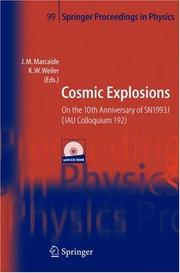
ISBN: 1280312475 9786610312474 354026633X 3540230394 3642421873 Year: 2005 Publisher: Berlin ; New York : Springer,
Abstract | Keywords | Export | Availability | Bookmark
 Loading...
Loading...Choose an application
- Reference Manager
- EndNote
- RefWorks (Direct export to RefWorks)
The proceedings of the conference Supernovae 2003 (IAU colloquium 192) provides an extensive state-of-the-art survey of all theoretical and observational aspects of supernovae and gamma-ray bursts, as well as their impact on cosmology. This volume offers everyone working in this field an authoritative and comprehensive source of reference.
Supernovae --- Gamma ray bursts --- Astronomy. --- Astronomy, Astrophysics and Cosmology. --- Astrophysics. --- Astronomical physics --- Astronomy --- Cosmic physics --- Physics
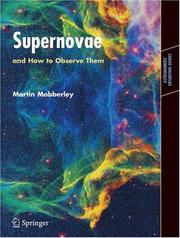
ISBN: 1280945079 9786610945078 0387462694 0387352570 Year: 2007 Publisher: New York : Springer,
Abstract | Keywords | Export | Availability | Bookmark
 Loading...
Loading...Choose an application
- Reference Manager
- EndNote
- RefWorks (Direct export to RefWorks)
Supernovae mark the deaths of massive stars or of white dwarfs in binary systems, and are unbelievably violent events. Even when they occur in galaxies millions of light years away they can be within the reach of amateur astronomers’ telescopes. More than 400 supernovae have already been discovered by amateurs. Supernovae and How to Observe Them is a mine of information for all levels of amateur astronomer, from relative beginners to experienced observers. Whether you are interested in the supernova physics, observing supernovae and supernova remnants, measuring their spectra or even discovering new supernovae yourself, this book provides all the information you need.
Supernovae --- Supernovas --- Cataclysmic variable stars --- X-ray sources, Galactic --- Astronomy. --- Popular Science in Astronomy. --- Astronomy, Observations and Techniques. --- Observations, Astronomical. --- Astronomy—Observations. --- Astronomical observations --- Observations, Astronomical
Book
ISBN: 3319218468 3319218476 331921845X Year: 2017 Publisher: Cham : Springer International Publishing : Imprint: Springer,
Abstract | Keywords | Export | Availability | Bookmark
 Loading...
Loading...Choose an application
- Reference Manager
- EndNote
- RefWorks (Direct export to RefWorks)
This reference work gathers all of the latest research in the supernova field areas to create a definitive source book on supernovae, their remnants and related topics. It includes each distinct subdiscipline, including stellar types, progenitors, stellar evolution, nucleosynthesis of elements, supernova types, neutron stars and pulsars, black holes, swept up interstellar matter, cosmic rays, neutrinos from supernovae, supernova observations in different wavelengths, interstellar molecules and dust. While there is a great deal of primary and specialist literature on supernovae, with a great many scientific groups around the world focusing on the phenomenon and related subdisciplines, nothing else presents an overall survey. This handbook closes that gap at last. As a comprehensive and balanced collection that presents the current state of knowledge in the broad field of supernovae, this is to be used as a basis for further work and study by graduate students, astronomers and astrophysicists working in close/related disciplines, and established groups. Editorial Board EDITORS-IN-CHIEF Athem W. Alsabti University College London Observatory, University College London, London, UK Sections: Supernovae and Supernova Remnants Supernovae and the Environment of the Solar System Paul Murdin Institute of Astronomy, University of Cambridge, Cambridge, UK Section: Supernovae and Supernova Remnants SECTION EDITORS David Arnett Steward Observatory,University of Arizona, Tucson, AZ, USA Section: Nucleosynthesis in Supernovae Phil Charles University of Southampton, School of Physics and Astronomy, Southampton, UK Section: Stellar Remnants - Neutron Stars and Black Holes Robert A. Fesen Department of Physics and Astronomy, Dartmouth College, Hanover, NH, USA Section: Evolution of Supernovae and the Interstellar Medium David A. Green Cavendish Laboratory, University of Cambridge, Cambridge, UK Section: Historical Supernovae Mario Hamuy Astronomy Department, University of Chile, Santiago, Chile; Millennium Institute of Astrophysics, Santiago, Chile Section: Cosmology from Supernovae Peter Hoeflich Department of Physics, Florida State University, Tallahassee, FL, USA Section: Explosion Mechanisms of Supernovae Ken’ichi Nomoto Kavli Institute for the Physics and Mathematics of the Universe (WPI), The University of Tokyo, Kashiwa, Chiba, Japan Section: Supernovae and Stellar Evolution Stephen Smart Astrophysics Research Centre, Queen's University, Belfast; Northern Ireland, UK Section: Light Curves and Spectra of Supernovae Mark Sullivan School of Physics and Astronomy, University of Southampton, Highfield, Southampton, UK Section: Types of Supernovae Friedrich-Karl Thielemann Department of Physics, University of Basel, Basel, Switzerland Sections: Neutrinos, Gravitational Waves and Cosmic Rays Nucleosynthesis in Supernovae Chengmin M. Zhang National Astronomical Observatories, Chinese Academy of Sciences, Beijing, China; Key Laboratory of Radio Astronomy, CAS, Beijing, China; School of Physical Science, University of Chinese Academy of Sciences, Beijing, China Section: Stellar Remnants - Neutron Stars and Black Holes.
Physics. --- Nuclear chemistry. --- Astronomy. --- Astrophysics. --- Cosmology. --- Astronomy, Astrophysics and Cosmology. --- Nuclear Chemistry. --- Chemistry, Nuclear --- Chemistry, Physical and theoretical --- Astronomical physics --- Astronomy --- Cosmic physics --- Physics --- Supernovae --- Nuclear chemistry --- Astrophysics --- Astronomy, Cosmology and Space Sciences.
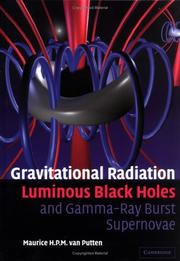
ISBN: 9780521849609 0521849608 9780511535260 9780521143615 0511126204 9780511126208 9780511124068 0511124066 0511125348 9780511125348 1280449241 9781280449246 0511535260 0521143616 1107153352 9786610449248 0511182287 0511199708 0511300263 Year: 2005 Publisher: Cambridge ; New York : Cambridge University Press,
Abstract | Keywords | Export | Availability | Bookmark
 Loading...
Loading...Choose an application
- Reference Manager
- EndNote
- RefWorks (Direct export to RefWorks)
Black holes and gravitational radiation are two of the most dramatic predictions of general relativity. The quest for rotating black holes - discovered by Roy P. Kerr as exact solutions to the Einstein equations - is one of the most exciting challenges facing physicists and astronomers. Gravitational Radiation, Luminous Black Holes and Gamma-Ray Burst Supernovae takes the reader through the theory of gravitational radiation and rotating black holes, and the phenomenology of GRB-supernovae. Topics covered include Kerr black holes and the frame-dragging of spacetime, luminous black holes, compact tori around black holes, and black-hole spin interactions. It concludes with a discussion of prospects for gravitational-wave detections of a long-duration burst in gravitational-waves as a method of choice for identifying Kerr black holes in the Universe. This book is ideal for a special topics graduate course on gravitational-wave astronomy and as an introduction to those interested in this contemporary development in physics.
Black holes (Astronomy). --- Gravitational waves. --- Supernovae. --- Black holes (Astronomy) --- Supernovas --- Cataclysmic variable stars --- X-ray sources, Galactic --- Gravitational radiation --- Gravity waves (Astrophysics) --- General relativity (Physics) --- Gravitational fields --- Radiation --- Waves --- Frozen stars --- Compact objects (Astronomy) --- Gravitational collapse --- Stars
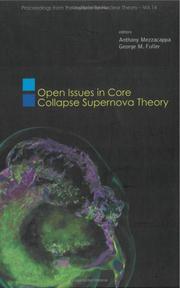
ISBN: 128190581X 9786611905811 9812703446 9789812703446 9812563148 9789812563149 Year: 2005 Volume: v. 14 Publisher: Hackensack, N.J. World Scientific
Abstract | Keywords | Export | Availability | Bookmark
 Loading...
Loading...Choose an application
- Reference Manager
- EndNote
- RefWorks (Direct export to RefWorks)
Efforts to uncover the explosion mechanism of core collapse supernovae and to understand all of their associated phenomena have been ongoing for nearly four decades. Despite this, our theoretical understanding of these cosmic events remains limited; two- and three-dimensional modeling of these events is in its infancy. Most of the modeling efforts over the past four decades have, by necessity, been constrained to spherical symmetry, with the first two-dimensional, albeit simplified, models appearing only during the last decade. Simulations to understand the complex interplay between the turbul
Supernovae --- Cataclysmic variable stars. --- Cataclysmic binary stars --- Cataclysmic variables (Stars) --- Eruptive variables (Stars) --- Explosive variables (Stars) --- Double stars --- Variable stars --- Supernovas --- Cataclysmic variable stars --- X-ray sources, Galactic --- Mathematical models
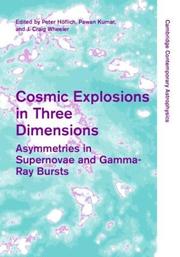
ISBN: 9780511536236 9780521842860 9781107403116 9780511265693 0511265697 0511261780 9780511261787 0511263406 9780511263408 0511264216 9780511264214 0511536232 1280749733 9781280749735 0521842867 1107163560 9786610749737 0511264976 0511317409 Year: 2004 Publisher: Cambridge, UK ; New York : Cambridge University Press,
Abstract | Keywords | Export | Availability | Bookmark
 Loading...
Loading...Choose an application
- Reference Manager
- EndNote
- RefWorks (Direct export to RefWorks)
Supernovae and gamma-ray bursts are the strongest explosions in the Universe. Observations show that, rather than being symmetrical, they are driven by strong jets of energy and other asymmetrical effects. These observations demand theories and computations that challenge the biggest computers. Originally published in 2004, this volume marked the transition to a fresh paradigm in the study of stellar explosions. It highlights the burgeoning era of routine supernova polarimetry and the insights into core collapse and thermonuclear explosions. With chapters by leading scientists, the book summarises the status of a fresh perspective on stellar explosions and should be a valuable resource for graduate students and research scientists.
Supernovae. --- Gamma ray bursts. --- Bursts, Cosmic gamma ray --- Bursts, Gamma ray --- Cosmic gamma ray bursts --- Transients, Gamma ray --- Gamma ray astronomy --- X-ray bursts --- Supernovas --- Cataclysmic variable stars --- X-ray sources, Galactic
Book
ISBN: 1489989250 1461422744 1461422752 Year: 2012 Publisher: New York : Springer,
Abstract | Keywords | Export | Availability | Bookmark
 Loading...
Loading...Choose an application
- Reference Manager
- EndNote
- RefWorks (Direct export to RefWorks)
In 1965 Fritz Zwicky proposed a class of supernovae that he called "Type V", described as "excessively faint at maximum." There were only two members, SN1961v and eta Carinae. We now know that eta Carinae was not a true supernova, but if it were observed today in a distant galaxy we would call it a "supernova impostor." 170 years ago it experienced a "great eruption" lasting 20 years, expelling 10 solar masses or more, and survived. Eta Carinae is now acknowledged as the most massive, most luminous star in our region of the Galaxy, and it may be our only accessible example of a very massive star in a pre-supernova state. In this book the editors and contributing authors review its remarkable history, physical state of the star and its ejecta, and its continuing instability. Chapters also include its relation to other massive, unstable stars, the massive star progenitors of supernovae, and the "first" stars in the Universe.
Astronomy. --- Eta Carinae. --- Supergiant stars. --- Variable stars. --- Supergiant stars --- Variable stars --- Astronomy & Astrophysics --- Physical Sciences & Mathematics --- Astrophysics --- Astronomy - General --- Supernovae. --- Supernovas --- Eta Car --- HD 93308 (Astronomy) --- Astronomy, Astrophysics and Cosmology. --- Cataclysmic variable stars --- X-ray sources, Galactic --- Astrophysics. --- Astronomical physics --- Astronomy --- Cosmic physics --- Physics
Book
ISBN: 146148135X 1461481368 Year: 2014 Publisher: New York, NY : Springer New York : Imprint: Springer,
Abstract | Keywords | Export | Availability | Bookmark
 Loading...
Loading...Choose an application
- Reference Manager
- EndNote
- RefWorks (Direct export to RefWorks)
What happens at the end of the life of massive stars? At one time we thought all these stars followed similar evolutionary paths. However, new discoveries have shown that things are not quite that simple. This book focuses on the extreme –the most intense, brilliant and peculiar– of astronomical explosions. It features highly significant observational finds that push the frontiers of astronomy and astrophysics, particularly as before these objects were only predicted in theory. This book is for those who want the latest information and ideas about the most dramatic and unusual explosions detected by current supernova searches. It examines and explains cataclysmic and unusual events in stellar astrophysics and presents them in a non-mathematical but highly detailed way that non-professionals can understand and enjoy.
Stars --- Supernovae. --- Evolution. --- Supernovas --- Stellar evolution --- Physics. --- Astronomy. --- Astrophysics. --- Cosmology. --- Nuclear physics. --- Astronomy, Astrophysics and Cosmology. --- Popular Science in Astronomy. --- Particle and Nuclear Physics. --- Cataclysmic variable stars --- X-ray sources, Galactic --- Evolution --- Compact objects (Astronomy) --- Atomic nuclei --- Atoms, Nuclei of --- Nucleus of the atom --- Physics --- Astronomical physics --- Astronomy --- Cosmic physics
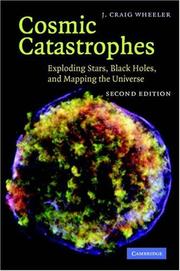
ISBN: 9780511536625 9780521857147 9781107437913 0511269110 9780511269110 0511267169 9780511267161 0511269579 9780511269578 9780511270130 0511270135 0511536623 9786610750481 6610750483 0521857147 1107166527 1316099474 1280750480 0511268440 051132300X 1107437911 9781107166523 9781316099476 9781280750489 9780511268441 Year: 2007 Publisher: Cambridge : Cambridge University Press,
Abstract | Keywords | Export | Availability | Bookmark
 Loading...
Loading...Choose an application
- Reference Manager
- EndNote
- RefWorks (Direct export to RefWorks)
From supernovae and gamma-ray bursts to the accelerating Universe, this is an exploration of the intellectual threads that lead to some of the most exciting ideas in modern astrophysics and cosmology. This fully updated second edition incorporates new material on binary stars, black holes, gamma-ray bursts, worm-holes, quantum gravity and string theory. It covers the origins of stars and their evolution, the mechanisms responsible for supernovae, and their progeny, neutron stars and black holes. It examines the theoretical ideas behind black holes and their manifestation in observational astronomy and presents neutron stars in all their variety known today. This book also covers the physics of the twentieth century, discussing quantum theory and Einstein's gravity, how these two theories collide, and the prospects for their reconciliation in the twenty-first century. This will be essential reading for undergraduate students in astronomy and astrophysics, and an excellent, accessible introduction for a wider audience.
Stars. --- Supernovae. --- Black holes (Astronomy) --- Hyperspace. --- Algebraic configurations in hyperspace --- Space of more than three dimensions --- Geometry --- Geometry, Differential --- Geometry, Non-Euclidean --- Mathematics --- Space and time --- Frozen stars --- Compact objects (Astronomy) --- Gravitational collapse --- Stars --- Supernovas --- Cataclysmic variable stars --- X-ray sources, Galactic --- Sidereal system --- Galaxies --- Circumstellar matter --- Foundations --- Black holes (Astronomy).
| Listing 1 - 10 of 13 | << page >> |
Sort by
|

 Search
Search Feedback
Feedback About UniCat
About UniCat  Help
Help News
News